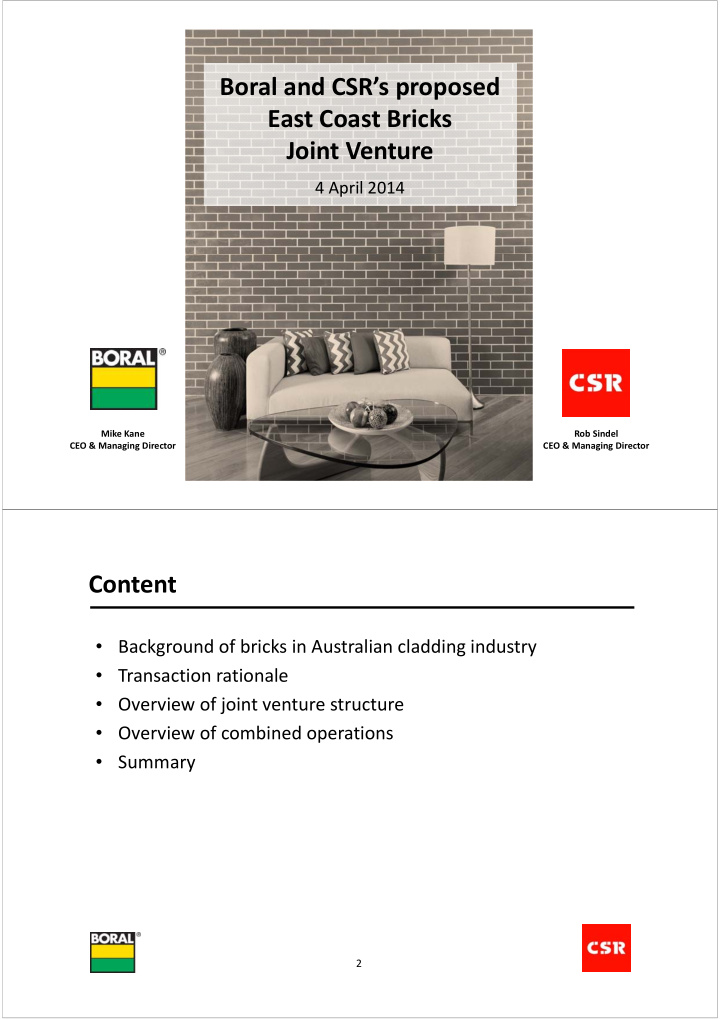



Boral and CSR’s proposed East Coast Bricks Joint Venture 4 April 2014 Mike Kane Rob Sindel CEO & Managing Director CEO & Managing Director Content • Background of bricks in Australian cladding industry • Transaction rationale • Overview of joint venture structure • Overview of combined operations • Summary 2
Background of bricks in cladding industry • Bricks are part of a broader cladding Australian brick production and bricks per housing start 1 industry • Sustained structural decline in demand for bricks over past 30 years • Total brick production down 46% from peak in 1981 • Decline more pronounced on east coast Brick production (m) Brick per start (‘000) of Australia – From 1991 to 2012, compound average annual rate of decline was 3% Qld, 3% NSW and 2% Vic 1 • Since 1981, brick intensity (number of bricks per dwelling) has almost halved : – Down 48% per housing start – Down 41% per detached housing start 1. Source: ABS data 3 Structural changes impacting brick demand Structural decline due to : High and medium density as a proportion of approvals • Change in dwelling mix away from (cumulative) 1 detached houses – traditionally more brick intensive – High rise dwellings have grown from under 1% to over 20% of total residential construction in last 20 years – High rise tends to favour concrete panels and façade solutions • Changing construction methods – Near elimination of double brick construction on east coast – Second storey construction using minimal brick – Frame and cladding systems using a range of products including single brick veneer • Emerging trends toward rendered walls and alternative cladding materials – Lighter weight alternatives to brick with faster construction times – Lower fixed cost of production 1. Source: ABS data 4
Bricks are competing in a broad cladding market Clay Masonry Fibre Concrete Autoclaved Composite Timber bricks blocks cement panels materials aerated concrete Reinforced Precast For load Hollow blocks Composite Light weight AAC products are cement (manufactured polymer based contemporary lightweight, bearing constructed produced as off ‐ site) and tilt ‐ external materials construction precast building from concrete panels or up wall panels cladding & face imitating materials boards (cast on ‐ site) brick façades natural products Other alternative non ‐ load bearing façades: Exterior insulation and finish systems (EIFS) • Structural Insulated Panel Systems (SIPS) • Metal walling • Permanent formwork • Other façades including aluminium, glass, vinyl and weatherboard • 5 Trends impacting bricks share of cladding market Pre ‐ 2000 Today Face brick commonly used on Rendering using common bricks Mixed cladding materials all external cladding and / or alternative cladding base with and without face brick 6
Transaction rationale • To create a sustainable competitive bricks business Strategy • Short to medium term: consolidate sales, admin and marketing overheads Optimise • Develop more efficient distribution networks, improve service and reduce operations costs • Longer ‐ term investment in manufacturing network to enable consolidation to lower cost, more efficient operating sites Reinvestment • Develop certain land assets without impacting product range and operational opportunities capability • Consolidation of overhead costs into one management structure • Further opportunities over medium to long term, excl property development Cost synergies • Cost synergies expected to position long ‐ term sustainable returns recovering the cost of capital through the cycle 7 Transaction structure • Structure reflects relative valuations of the businesses Retain Retain – No cash consideration Schofields, Scoresby, Vic NSW land title, • No immediate plans to close any land title, lease to JV lease to JV current brick operating sites Subdivide & Subdivide & • Transaction subject to ACCC retain retain surplus land at review surplus land Horsley Park, at Bringelly, • Change of control , which applies NSW and NSW Oxley, Qld to any entity in the chain of ownership, including the parent PGH bricks in NSW, Boral bricks in NSW, companies, triggers a call option Qld, Vic and SA Qld and Vic for the other party at fair market Schofields, NSW site Scoresby, Vic site used value used for the term of an for the term of an agreed lease period agreed lease period East Coast 60% Bricks Joint 40% Venture 8
Joint venture operations JV Sites – Boral sites • Combined annual revenue of ~ $230 m capacity by state (million SBE) CSR sites • 606 million SBE (standard brick equivalent) of brick manufacturing capacity Queensland – 475m SBE in current operation Operating Site Mothball. – 131m SBE mothballed capacity • 12 manufacturing operations ‐‐‐ Darra 56 Oxley 90 ‐‐‐ (including mothballed sites) • Current funds employed in East Coast bricks New South Wales Operating – Circa $100m for Boral Site Mothball. capacity – Circa $140m for CSR (PGH) Bringelly 65 ‐‐‐ ` Badgery’s Creek ‐‐‐ 63 • Around 540 combined Cecil Park 47 43 employee base Schofields 47 ‐‐‐ Horsley Park 15 ‐‐‐ Bathurst ‐‐‐ 25 South Australia Operating Victoria Site Mothball. capacity Operating Site Mothball. Golden Grove 40 ‐‐‐ capacity Scoresby 31 ‐‐‐ Thomastown 55 ‐‐‐ 9 Albury 29 ‐‐‐ Summary Long term commitment by Boral and CSR to Australian brick industry • Improves economic viability of operations, ensuring a more competitive • brick business within a broader cladding market Increased capacity to invest in product development , technical • efficiency and support for bricklaying trades and apprentice programs Provides opportunity to develop more efficient freight and distribution • networks to improve service and lower costs A stronger and more competitive business provides more opportunities • for our people and maintains choice for consumers 10
QUESTIONS Mike Kane Rob Sindel CEO & Managing Director CEO & Managing Director
Recommend
More recommend